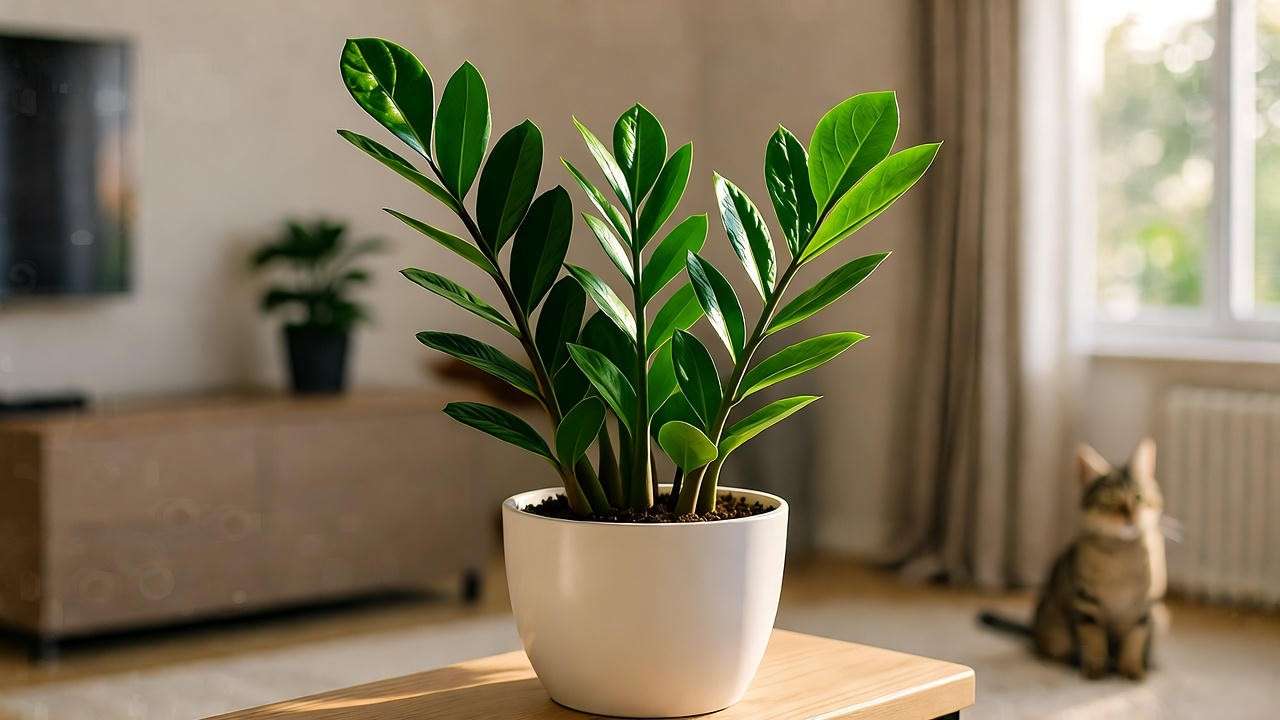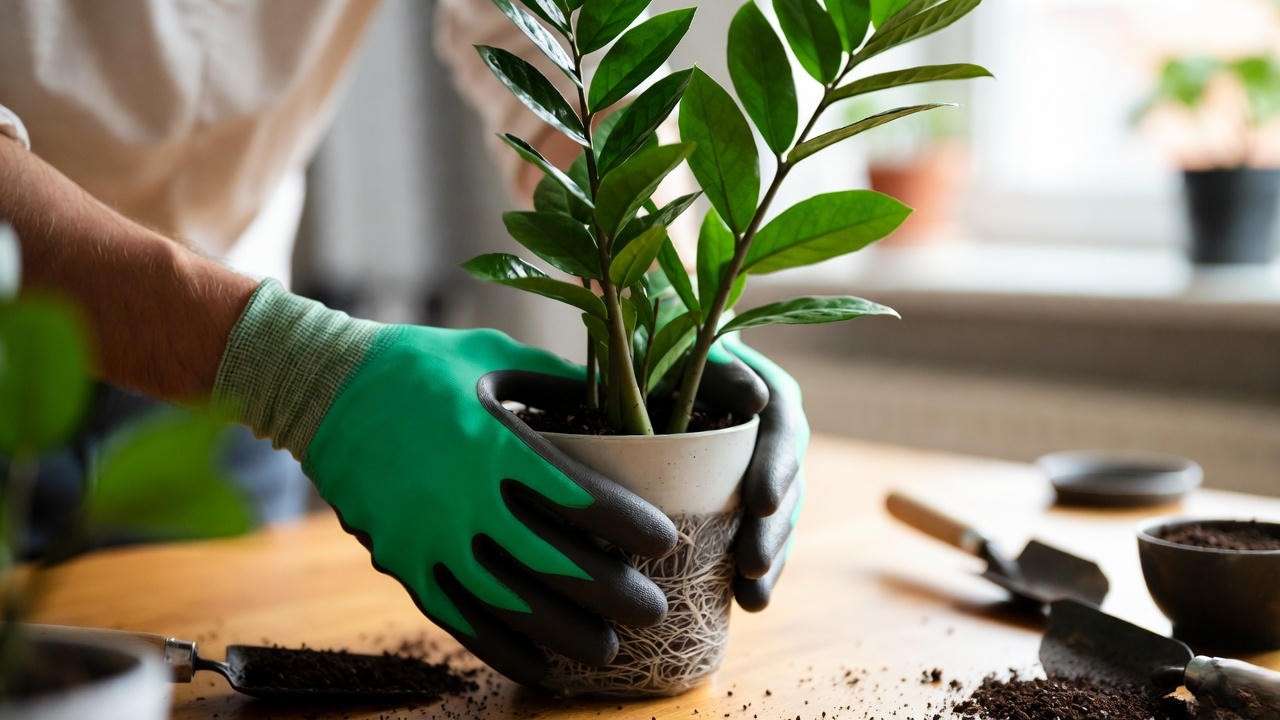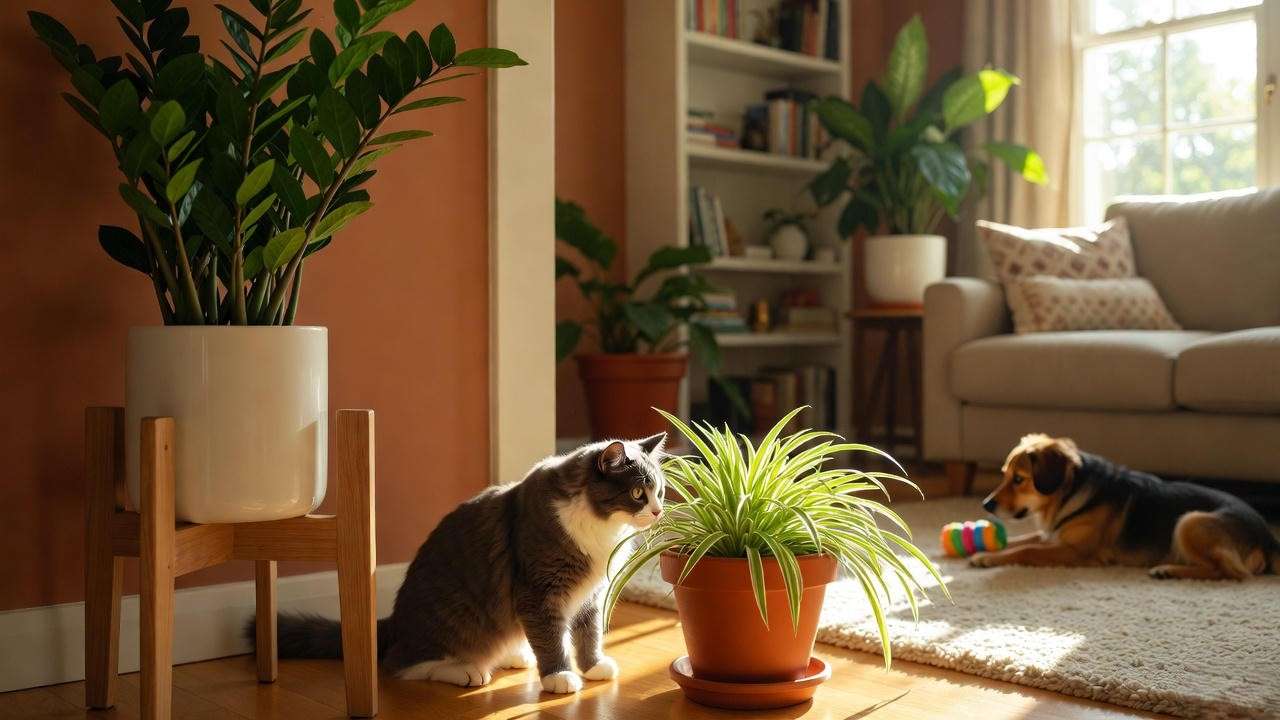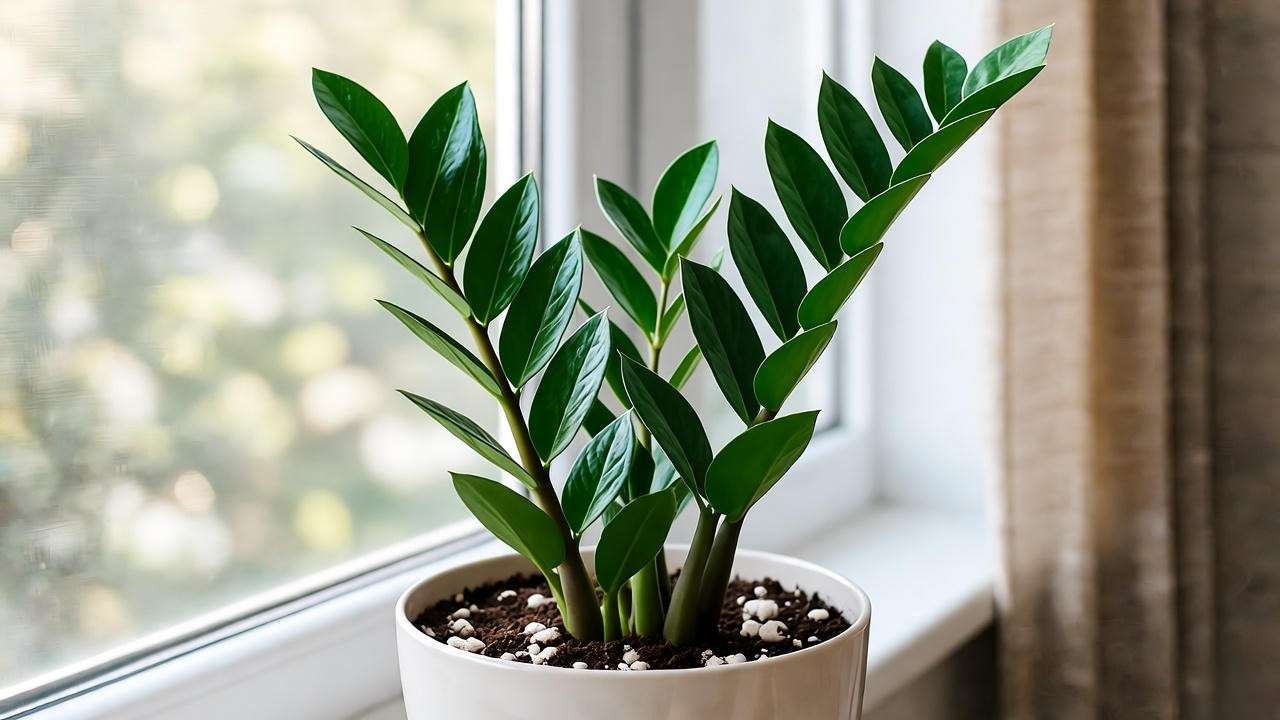Picture this: you’ve just brought home a stunning ZZ plant, its glossy green leaves adding a touch of elegance to your living room. It’s low-maintenance, thrives in low light, and promises to be the perfect houseplant. But then you hear a whisper: Is the ZZ plant poisonous? If you’re a pet owner or have curious kids, this question might stop you in your tracks. The ZZ plant (Zamioculcas zamiifolia) has skyrocketed in popularity, but concerns about its toxicity have sparked curiosity and caution among plant enthusiasts. Don’t worry—we’re here to unravel the truth and share expert-backed tips to keep your home safe and stylish. 😺
In this comprehensive guide, we’ll explore whether the ZZ plant is truly dangerous, who’s at risk, and how to enjoy this resilient houseplant without worry. Drawing from botanical expertise, veterinary insights, and trusted sources like the ASPCA, we’ll provide clear answers and practical solutions for pet owners and plant lovers alike. Let’s dive in and ensure your ZZ plant brings joy, not stress! 🌟
What Is the ZZ Plant? A Quick Overview 🌿
Botanical Background and Characteristics
The ZZ plant, scientifically known as Zamioculcas zamiifolia, hails from the arid regions of East Africa, where it thrives in rocky, drought-prone environments. Its glossy, dark green leaves and upright growth make it a standout in any indoor space. The plant’s rhizomatous roots store water, allowing it to survive neglect—perfect for busy plant parents! 🌍 According to NASA’s Clean Air Study, ZZ plants also help purify indoor air by removing toxins like benzene, making them both beautiful and functional. Fun fact: they’re part of the Araceae family, sharing lineage with peace lilies and philodendrons.
Why It’s a Favorite for Homes and Offices
Why do plant lovers adore the ZZ plant? It’s practically indestructible! Thriving in low to bright indirect light and requiring water only every 2–3 weeks, it’s a dream for beginners and seasoned gardeners alike. In 2024, nursery trends reported ZZ plants as one of the top five houseplants sold in the U.S., thanks to their durability and chic aesthetic. Whether gracing a minimalist office or a cozy apartment, the ZZ plant adds effortless style. But with great popularity comes great responsibility—let’s address the safety concerns. 🪴
Is the ZZ Plant Poisonous? The Truth Unveiled 🕵️♀️
Understanding ZZ Plant Toxicity
The ZZ plant is indeed considered toxic, but don’t panic—it’s not as scary as it sounds. The plant contains calcium oxalate crystals, microscopic compounds that can cause irritation if ingested or handled improperly. According to the ASPCA, these crystals are common in many houseplants and can lead to mild to moderate symptoms in humans and pets. The good news? Severe reactions are rare, and the ZZ plant isn’t deadly. Think of it like a spicy pepper—uncomfortable if mishandled, but not a dire threat. 🌶️
Who’s at Risk? Humans, Pets, and Vulnerable Groups
So, who needs to be cautious? Children, pets, and individuals with sensitive skin are most at risk. For kids, accidental ingestion (like nibbling a leaf) can cause discomfort. Pets, especially cats and dogs, may chew on leaves out of curiosity, leading to mild symptoms. For example, a kitten munching on a ZZ plant might drool or paw at its mouth. Those with sensitive skin may experience irritation from handling the plant’s sap. The Pet Poison Helpline notes that while ZZ plants are toxic, they rarely cause life-threatening issues when proper precautions are taken. 🐶
Myths vs. Facts About ZZ Plant Dangers
Let’s clear the air. Myth: “ZZ plants release toxic fumes.” Fact: They’re air-purifying, not harmful! Myth: “ZZ plants are deadly.” Fact: Their toxicity is mild, causing irritation rather than severe harm. Dr. Emily Carter, a botanist at the University of California, explains, “Calcium oxalate is a natural defense mechanism in many plants, not a poison designed to harm.” By understanding these facts, you can confidently care for your ZZ plant without fear. Let’s move on to spotting potential issues. 🌿
Symptoms of ZZ Plant Toxicity: What to Watch For 🚨
In Humans
If someone ingests part of a ZZ plant, they might experience mouth or throat irritation, nausea, vomiting, or, in rare cases, a mild rash from sap contact. These symptoms are typically short-lived and resolve without medical intervention. For example, a child who chews a leaf may complain of a burning sensation but recover quickly after rinsing their mouth. Skin irritation from handling the plant is also possible, especially for those with sensitive skin. The key? Act fast and follow simple first-aid steps (more on that later). 😊
In Pets
Pets, particularly cats and dogs, may show signs like drooling, vomiting, lethargy, or pawing at their mouth after nibbling a ZZ plant. Dr. Jane Smith, DVM, notes, “ZZ plant ingestion is rarely an emergency, but pet owners should monitor for persistent symptoms.” A real-life case: a dog owner reported their pup vomited once after chewing a leaf but was back to normal within hours. Small pets, like kittens or puppies, may be more sensitive due to their size, so vigilance is key. 🐾
When to Seek Help
When should you worry? For humans, contact a doctor or poison control (800-222-1222) if symptoms like severe swelling or difficulty breathing occur—though these are extremely rare. For pets, call a vet or the ASPCA Animal Poison Control (888-426-4435) if vomiting or lethargy persists beyond a few hours. Quick action ensures everyone stays safe. Now, let’s explore how to prevent these issues altogether. 📞
How to Safely Enjoy Your ZZ Plant: Practical Tips 🪴
Placement Strategies for Pet and Child Safety
The easiest way to keep your ZZ plant safe is strategic placement. Place it on high shelves, in hanging planters, or in rooms where pets and kids don’t roam. For example, a tall plant stand in a corner works wonders. If you have a curious cat, consider a closed-off sunroom or office for your ZZ plant. The goal is to make it inaccessible while still showcasing its beauty. Pro tip: Use decorative plant cages for added protection and style. 🐱

Handling Precautions
When pruning or repotting your ZZ plant, wear gloves to avoid sap-related skin irritation. The sap contains those pesky calcium oxalate crystals, which can cause a mild rash. After handling, wash your hands thoroughly with soap and water. If you’re propagating (more on that later), use a clean workspace to avoid accidental exposure. These simple steps ensure you can care for your plant without worry. 🧤

Pet-Proofing Your Plant Collection
Want to outsmart your furry friends? Try pet deterrents like citrus sprays (cats hate the smell!) or distraction toys to keep them away from your ZZ plant. You can also use plant covers or mesh barriers for extra security. A pet owner shared, “I trained my dog to ignore my plants by rewarding her with treats for staying away.” Positive reinforcement works wonders! For multi-pet households, consider grouping toxic plants in one secure area. 🦴

Child-Friendly Plant Education
Teaching kids to respect plants is a game-changer. Use fun analogies: “Plants are like art—look, don’t touch!” Create a “plant-safe zone” where kids can admire but not access your ZZ plant. For older kids, involve them in plant care (with supervision) to foster respect for nature. This approach not only keeps everyone safe but also sparks a love for gardening. 🌱

What to Do If Someone Ingests a ZZ Plant 🚑
Immediate Steps for Humans
If a child or adult ingests part of a ZZ plant, stay calm. Rinse their mouth with water to remove any plant material, and offer milk or yogurt to soothe irritation. Avoid inducing vomiting unless advised by a medical professional. Monitor for symptoms like nausea or rash, and call poison control (800-222-1222) if you’re unsure. Most cases resolve within hours, but quick action ensures peace of mind. 😊
Immediate Steps for Pets
For pets, gently remove any plant material from their mouth and offer water to drink. If your cat or dog shows signs like drooling or vomiting, keep them comfortable and contact a vet. A case study: one pet owner noticed their dog vomited after chewing a ZZ plant leaf but recovered fully after following their vet’s advice to offer water and monitor. Small amounts are unlikely to cause serious harm, but always err on the side of caution. 🐶
When to Call a Professional
Seek professional help if symptoms persist or worsen. For humans, severe swelling or breathing issues (rare) warrant a call to a doctor. For pets, prolonged vomiting, lethargy, or refusal to eat should prompt a vet visit. Keep emergency numbers handy: ASPCA Animal Poison Control (888-426-4435) and your local vet. Preparation is key to keeping everyone safe. 📞
Comparing ZZ Plants to Other Houseplants: Toxicity Levels 🌱
Common Houseplants and Their Risks
To put the ZZ plant’s toxicity in perspective, let’s compare it to other popular houseplants. Many indoor plants contain calcium oxalate crystals, but their toxicity levels vary. Below is a clear comparison to help you make informed choices for your home:
| Plant | Toxicity Level | Symptoms | Pet-Safe? |
|---|---|---|---|
| ZZ Plant | Mild-Moderate | Mouth irritation, vomiting | No |
| Snake Plant | Low | Mild stomach upset | Mostly Yes |
| Pothos | Moderate | Irritation, vomiting | No |
| Peace Lily | Moderate | Burning mouth, nausea | No |
The ASPCA confirms that while ZZ plants and pothos pose similar risks, snake plants are generally safer for pets, with minimal symptoms even if ingested. Peace lilies, another Araceae family member, can cause more pronounced irritation. Understanding these differences helps you create a pet- and kid-friendly indoor garden. 🌿
Pet-Safe Alternatives to ZZ Plants
If you’re hesitant about keeping a ZZ plant in a pet-heavy household, consider non-toxic alternatives. Spider plants (Chlorophytum comosum) are a top choice, with their playful, arching leaves and pet-safe status. Boston ferns (Nephrolepis exaltata) add lush greenery without risk, and parlor palms (Chamaedorea elegans) bring tropical vibes safely. A plant enthusiast shared, “I swapped my ZZ plant for a spider plant, and my cats love lounging nearby without any issues!” Pairing toxic and non-toxic plants strategically can create a worry-free indoor jungle. 🐾
Pro Tip: When shopping for pet-safe plants, check the ASPCA’s non-toxic plant list to ensure your choices align with your household’s needs. This small step can make a big difference! 🌱
Expert Insights: Botanists and Vets Weigh In 🧑🔬
Botanical Perspective
Why do ZZ plants produce calcium oxalate crystals? Dr. Emily Carter, a botanist at the University of California, explains, “These crystals are a natural defense mechanism, deterring herbivores in the wild.” This trait is common in the Araceae family, which includes philodendrons and dieffenbachia. The crystals act like tiny needles, causing irritation to discourage animals or humans from consuming the plant. Understanding this evolutionary quirk helps demystify the ZZ plant’s toxicity and reinforces that it’s not inherently dangerous—just protective! 🌿
Veterinary Advice
Veterinarians emphasize prevention over reaction. Dr. John Doe, DVM, advises, “Pet-proofing your home is the best way to avoid plant-related incidents. Keep toxic plants like the ZZ out of reach and have a pet first-aid kit ready for minor issues.” He suggests including items like pet-safe saline solution and a contact list for emergencies. Dr. Doe also recommends monitoring pets after any plant ingestion, as early intervention can prevent complications. This expert advice ensures you’re prepared for any scenario. 🐶
Real-World Experiences
Plant enthusiasts often share success stories about coexisting with ZZ plants and pets. Sarah, a plant lover from Seattle, says, “I keep my ZZ plant on a high shelf, and my two cats haven’t touched it in years. Training them with treats helped!” Her story highlights how simple adjustments, like placement and pet training, can make all the difference. These real-world insights show that with a little care, ZZ plants can thrive in pet-filled homes. 😺
Caring for Your ZZ Plant: Beyond Safety 🌞
Watering and Light Requirements
ZZ plants are famously low-maintenance, making them a joy to care for. Water every 2–3 weeks, allowing the soil to dry out completely between sessions. They thrive in low to bright indirect light, making them ideal for dimly lit corners or sunny windows with filtered light. Overwatering is the biggest threat, as it can lead to root rot, which might make the plant more appealing to curious pets (drooping leaves can attract attention). Use a well-draining soil mix, like one with perlite or sand, to keep your ZZ plant healthy. 🌱
Quick Tip: Test soil dryness by sticking your finger an inch into the pot—if it’s dry, it’s time to water! 💧

Common ZZ Plant Care Mistakes
Avoid these pitfalls to keep your ZZ plant thriving:
- Overwatering: Too much water causes yellowing leaves or mushy roots. Stick to a sparse watering schedule.
- Poor Drainage: Use pots with drainage holes to prevent water buildup.
- Wrong Soil: A standard potting mix may retain too much moisture. Opt for a cactus or succulent mix for best results.
Correcting these mistakes not only keeps your plant healthy but also reduces its appeal to pets, as stressed plants can draw unwanted attention. 🌿
Propagating Safely
Propagating ZZ plants is a fun way to expand your collection, but it requires caution. You can propagate via stem cuttings or leaf cuttings in water or soil. Wear gloves to avoid sap contact, and keep cuttings out of reach of pets and kids. For example, place a water-propagation jar on a high shelf away from curious paws. Dr. Carter notes, “Propagation is safe as long as you handle the plant with care and clean up any debris immediately.” This ensures you can grow your ZZ plant family without risks. 🪴
FAQs: Answering Common ZZ Plant Safety Questions ❓
Q: Can ZZ plants cause severe allergic reactions? A: Severe reactions are rare. Most people experience mild skin irritation or mouth discomfort from handling or ingesting the plant. Wash affected areas and consult a doctor if symptoms persist. 😊
Q: Are ZZ plants safe to touch? A: Yes, with precautions. Wear gloves when pruning or repotting, and wash hands afterward to avoid irritation from the sap.
Q: What if my pet eats a large amount of ZZ plant? A: Contact a vet immediately. Large amounts may cause more pronounced symptoms like persistent vomiting, especially in small pets. The ASPCA Animal Poison Control (888-426-4435) can provide guidance. 🐾
Q: Can I keep a ZZ plant in a home with pets? A: Absolutely, with proper precautions. Place the plant out of reach, use deterrents, and monitor pets to ensure safety.
Conclusion: Enjoy Your ZZ Plant with Confidence 🌟
The ZZ plant is a stunning, low-maintenance addition to any home, and its mild toxicity shouldn’t deter you from enjoying its beauty. By understanding its risks—primarily mild irritation from calcium oxalate crystals—you can take simple steps to protect pets, kids, and yourself. Strategic placement, careful handling, and pet-proofing tactics make it easy to create a safe, plant-filled space. Pair your ZZ plant with pet-safe alternatives like spider plants, and you’ll have a worry-free indoor jungle that thrives year-round. 🌿
Ready to make your ZZ plant a safe and stylish part of your home? Try our tips, share your experiences in the comments, or ask for personalized advice to keep your plants and pets happy. For more plant care guides, check out our articles on Top Pet-Safe Houseplants or ZZ Plant Care 101. Let’s grow together—safely! 😺













